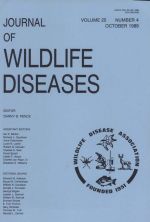Ninety-nine mule deer (Odocoileus hemionus) from four Utah counties (Cache, Utah, Sanpete and Sevier) were examined for larvae of Cephenemyia spp. in 1985 and 1986. Numbers of first, second and third stage bot fly instars were related to age, sex, year and geographic location of the mule deer. Fawns and adult deer ≥5.5 yr had a significantly (P ≤ 0.05) higher intensity (x̄ = 37 and x̄ = 68, respectively) of infection than the 1.5- and 2.5-yr-old age groups (x̄ = 19 and x̄ = 26, respectively). Infection by larvae was not significantly different between sexes. Infection was 100% in both years, but the mean intensity was significantly lower in 1986 (P < 0.05). The decline may be related to differences in soil moisture between the 2 years. In 1985, 82% of the deer examined were infected with all three instars. Seventy-seven percent of all first instar larvae were observed in the trachea, usually in the fold immediately posterior to the epiglottis and corniculate cartilages. This new site of attachment for first instar larvae has not previously been recognized.
How to translate text using browser tools
1 October 1989
Bot Fly Larvae (Cephenemyia spp. Oestridae) in Mule Deer (Odocoileus hemionus) from Utah
D. C. McMahon,
T. D. Bunch

Journal of Wildlife Diseases
Vol. 25 • No. 4
October 1989
Vol. 25 • No. 4
October 1989
Bot fly larvae
Cephenemyia spp
host and locality factors
mule deer
Odocoileus hemionus
Oestridae survey




